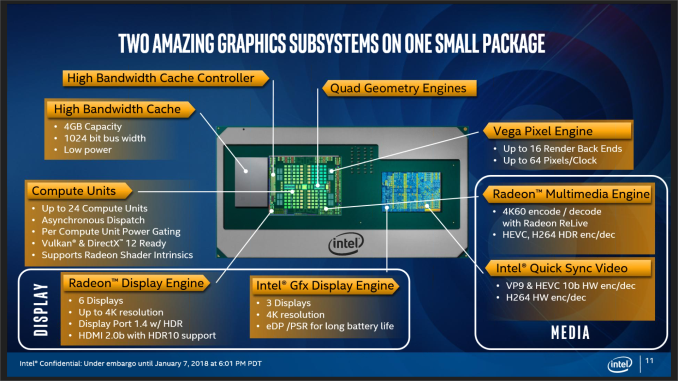Intel Core with Radeon RX Vega M Graphics Launched: HP, Dell, and Intel NUC
by Ian Cutress on January 7, 2018 9:02 PM ESTSo Why Two Sets of Graphics?
To answer this question, there can be a few possible answers.
The cynical approach is to say that Intel is rehashing a H-series design for the CPU portion, so rather than spending money to make masks that cuts it off, Intel is being cheap for what would be a low volume product.
A technical reason, which readers may or may not agree with, is to do with functionality and power. Despite these chips being 65W and 100W, we are going to see them being used in 15-inch and 17-inch high-end devices, where design is a lifestyle choice but also battery life is a factor to consider. For doing relatively simple tasks, such as video decoding or using eDP, firing up a big bulky graphics core with HBM2 is going to drain the batteries a lot faster. By remaining on the Intel HD graphics, users can still have access to those low power situations while the Radeon graphics and HBM2 are switched off. There is also the case for Intel’s QuickSync, which can be used in preference of AMD encoders in a power-restricted scenario.
The Radeon graphics in this case offers power-gating at the compute-unit level, allowing the system to adjust power as needed or is available. It provides an additional six displays up to 4K with the Intel HD graphics that has three, giving a total of nine outputs. The Radeon Graphics supports DisplayPort 1.4 with HDR and HDMI 2.0b with HDR10 support, along with FreeSync/FreeSync2. As a result, when the graphics output changes from Intel HD Graphics to Radeon graphics, users will have access to FreeSync, as well as enough displays to shake a stick at (if the device has all the outputs).
Users that want these new Intel with Radeon Graphics chips in desktop-class systems, might not find much use for the Intel HD graphics. But, for anything mobile or power related, and, especially for anything multimedia related, it makes sense to take advantage of the Intel iGPU.











66 Comments
View All Comments
mczak - Monday, January 8, 2018 - link
FWIW apple has shipped plenty MBPs where the charger isn't quite sufficient. These will drain the battery a little even if plugged in when running at full tilt (and at least some of them also have the habit of running really really slow if the battery isn't just old but completely dead because they will be forced to low power states).Albeit I agree for a 89W charger a 100W cpu+gpu is probably too much, since together with the rest of the system that might amount to a sustained power draw of over 110W, which would drain the battery too fast. But if apple wants a 80W version of it, I'm pretty sure intel would just deliver that, those limits can be easily changed.
Kevin G - Sunday, January 7, 2018 - link
And MS SQL Server is available for Linux. I think hell has frozen over.tracker1 - Monday, January 8, 2018 - link
For what it's worth, MS SQL Server on Linux/Docker is fairly limited, and the mgt software is still windows based, though you can do anything you need via sql execute statements... it's not the friendliest. I usually treat my database as mostly dumb anyway.Zingam - Sunday, January 7, 2018 - link
But does it melt down?haukionkannel - Monday, January 8, 2018 - link
Yes it does.B166ER - Sunday, January 7, 2018 - link
I just don't get this marriage. It seems the graphics power is juuust a wee bit over intels cores, so what graphics need would this push? "Oh look I get 5 more fps in Minecraft!"??schizoide - Sunday, January 7, 2018 - link
I thought it would be faster than that, so i did some back of the napkin math. 24 CUs = 43% of a Vega 56, but 19% slower on the GPU and 50% slower on the HBM. Seems reasonable to guess it will offer about 25% the performance of a Vega 56.Vega56 gets 20k in 3DMark, 25% of that is 5k. The fastest iGPU I could find on futuremark's site is the 6700HQ, which scored 7910. So... it's slower than the fastest intel GPU from 2 years ago. Is that right?
schizoide - Sunday, January 7, 2018 - link
Yeah that wasn't right, futuremark switched it from GPU to CPU when I searched for Intel. The fastest GPU score I could find for an Intel iGPU was the Iris Pro 6200 from the Broadwell generation. It got 1630. Skylake improved the iGPU quite a lot but I can't find the benchmarks offhand.JohnPec - Monday, January 8, 2018 - link
Linus said it will be as good as 1060maxq or better.tipoo - Sunday, January 7, 2018 - link
Hm? It's definitely a fair shot over the Iris Plus 650, and the Pro line seems dead after the Pro 580. This will absolutely be 3-4x over an Iris Plus 650, let alone the eDRAM-less Iris HD 630 thrown in there.What did you mean by barely above the Intel part? I see nothing close.